Published date
Related Collections from the Archive
Related content
From the book: All That Glitters by Emilia Potenza
This feature has explored the devastating changes that industrialisation brought for the majority of people in South Africa. From being farmers with varying degrees of independence, most people became involved in one or other form of wage labour. A large number were forced to become labourers on white-owned farms. Here a labour tenant from Vrede describes aspects of his working life in 1926.
I don't know what terms were made on the contract by my father...
My parents and five of my sisters and me are all farm-hands and we all get no pay for services. We serve only to have a right of settling on the farm. We start work form early sunrise until sunset daily except Sundays when we have a whole day's rest... My father redeives a pasela (present) of three pnds after some years of real backstrained farm work, evedently in a good year when the baas realises that the yields of the crops have made for him big didvidends. - Adapted from "The Workers' Herald", the newspaper of the ICU, 15 November, 1926
Those who became migrant labourers on the mines also experienced violent changes in their lives. These changes were brought about by separation from their rural homesteads, being treated as second-class citizens, working in very dangerous conditions, living in cramped compounds without any privacy and earning low wages.
Like mineworkers, factory workers also had to battle to survive. Whether they were black men or white women, they were paid very low wages. Out of their meagre wages, they had to try to support themselves, as well as send money to their families in the rural areas. To begin with, factory workers were not provided with housing. They had to struggle to find accommodation, and usually had to share a small room with three or four others. Often they had to make do without any water or electricity.
Many also had to find ways of creating jobs for themselves in order to eke out a living. They became part of the informal sector, and worked as hawkers, beer-brewers or even prostitutes. They, too, had the problem of finding housing.
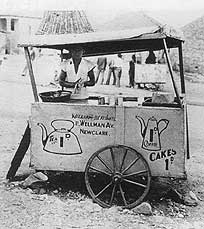 A township 'coffee cart', probably late 1930s or early 1940s
A township 'coffee cart', probably late 1930s or early 1940s
For all workers, it was a struggle to keep on the right side of the law, which was designed to keep Africans out of the cities. Laws were also passed to control the movements of Africans both on the farms and in the cities.
But workers in the cities, as well as farmworkers who remained in the rural areas, didn't just sit back and accept all these controls. As they struggled to survive in their changing worlds, many fought to overcome their hardships.
Workers' resistance in South Africa
The way in which workers in South Africa, both urban and rural, fought against the harshness of their working and living conditions took many different forms:
workers resisted* in small, ongoing ways on a daily basis
- as trade unions developed, workers began to use more organised strike action.
Everyday forms of resistance
... among farmworkers
Resistance among farmworkers took a variety of forms. Some farmers were forced to leave districts because farmworkers got together and decided to 'starve these farmers of labour'. In response to poor wages, labourers deserted*; when they were beaten, workers set fire to farmers' property. In East Griqualand, poisoning of stock cost farm owners about 6 000 pounds over a couple of years in the later 1920s. Countrywide, 147 000 beasts were reported stolen in 1927. For many, stealing was just 'another way of making ends meet'. In some cases, the hatred that farmworkers developed for their masters drove them to poison them.
”¦on the sugar plantations
Indentured labourers in Natal resisted their difficult working conditions by pretending to be sick, missing work or deserting.
”¦on the diamond fields
The workers on the Kimberley diamond fields found ways of escaping the drudgery of their lives. They used heavy drinking as a form of relaxation and escape. This also had an effect on their working lives.
Drinking too much during the weekends meant that many workers were too hung-overed to report for work on a Monday. Withdrawing their labour in this way had a direct impact on production. Mozambican workers on the diamond fields also withdrew their labour by returning home during winter because they couldn't stand the cold weather.
”¦. on the gold mines
Another form of resistance was to look for better jobs. After the South African War (1899-1902), thousands of African workers boycotted the gold mines because wages had dropped. They tried to find jobs on the railways and in the towns instead.
As with indentured labourers, workers on the gold mines also deserted when they were unable to do anything else to improve their jobs. Where conditions in compounds were the worst, desertion was higher.
Many workers also tried to limit their work by deliberately working badly, breaking their tools and not doing any more work than they had to. Often workers acted 'stupid' by pretending that they didn't understand their orders.
Although employers could have their workers tried for these 'crimes', the courts were often ineffective. As a result, there was very little employers could do to put a stop to many of these 'everyday' forms of resistance.
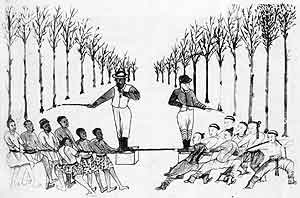 Mine owners disagreed about whether African labour as better than Chinese labour
Mine owners disagreed about whether African labour as better than Chinese labour
Some key moments in resistance from 1902 - 1921
Although there were many smaller forms of organised protest throughout this period, only the more significant moments of resistance have been highlighted below. The focus is mainly on worker resistance.
1907:White miners went on strike in protest against the importation of Chinese workers.
1911:Indian plantation workers went on strike over working conditions.
1912:The South African Native National Congress (later the African National Congress, or ANC) was formed to protest the proposed passing of the Land Act.
1913:African miners went on strike over wages and conditions in the compounds.
White miners also went on strike over the number of hours they were expected to work on a Saturday.
Indian workers went on strike demanding that the tax of three pounds imposed on ex-indentured men, women and children be removed.
1920:Almost 70 000 African miners went on strike to demand a wage increase. Of the 35 mines, 21 were brought to a standstill during the strike.
1921:The Communist Party of South Africa was formed (renamed the SACP in 1953). Their aim was to promote solidarity among all workers black or white.
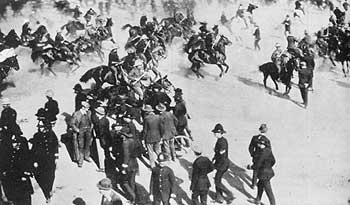 Police disperse a trsike meeting, Market Square, Johannesburg, 1913
Police disperse a trsike meeting, Market Square, Johannesburg, 1913
Dealing with people protesting
Over the last century, many people throughout our country have protested about a whole range of different issues.
The 1922 Rand Revolt
After the protest by white miners in 1913, the Chamber of Mines recognised white trade unions in 1914. Production increased between 1911 and 1920. This was a period of stability and profit for the mine owners. But by 1920 the price of gold was dropping and the mine owners were facing greater resistance from African workers.
A decision was taken by the mine owners to keep production costs down by lowering the wages of white workers. The mine owners also wanted to employ more Africans instead of whites to do semi-skilled work as they could pay them less.
The white unions refused to accept these changes. In January 1922 a general strike was called of all white miners. About 25 000 miners went on strike. Strike committees were formed to organise and control the strike. Workers organised themselves into commandos which attacked African workers who tried to go to work. The slogan of some white miners was: 'Workers of the World Unite and Fight for a White South Africa'.
This strike by white miners lasted for eight weeks and was followed by two weeks of armed revolt. The government under General Smuts sent in 7 000 armed troops and a number of bomber planes to deal with the strikers. Over 500 people were injured, and 153 people were killed. Five thousand strikers were arrested. Four men were sentenced to death and hanged as a result of the strike. The white miners had lost the strike.
However, in response to the strike the government introduced several laws that protected white workers. Amongst other things, these laws were designed to prevent black and white workers from forming a united front against management or the government.
The first national black trade union
During the 1920s an unexpected political force took root throughout South Africa. Africans, coloureds and Indians came together under the banner of the Industrial and Commercial Workers' Union of South Africa (ICU). For the first time in the country's history, black workers countrywide united to give voice to their anger about their lives and their working conditions.
The black workers on the mines and in factories had to struggle on many fronts: they had to fight against low wages and very bad working conditions; they had to deal with the racism of white workers and management, as well as of the government. In addition, they usually had to live in appalling conditions.
Farmworkers also had much to be angry about: they were extremely poorly paid and worked very long hours. A large number of these workers were labour tenants. They depended for survival on what they could produce on their own plots. From 1924 white farm owners began to take more and more land from their tenants. They wanted to put this land under production using their new machinery and improved farming methods. Many tenants received eviction notices. The impact on tenants was that their ability to survive was being threatened.
Both urban and rural workers began to see this new union, the ICU, as their saviour. The leader of the ICU was a man called Clements Kadalie. The song in below captures one aspect of what the ICU achieved.
You young man of Kadalie.
You have come to unite
Flocks that spurn each other,
Shangaans, coloureds,
Son of a blacck man
In the land of our ancestors.- From "Pondoland"
How did the Industrial and Commercial Union of South Africa (ICU) manage to spread to so many parts of the country, both urban and rural, in such a short space of time? At the height of its power in 1927 it claimed a membership of about 100 000. Yet quite surprisingly by 1930, only three years later, the ICU had virtually collapsed.
Why did the ICU grow so quickly and then decline so quickly? The introduction to the ICU, which you have just read, together with the information provided in the next section, will help you to think about the answer to this question.
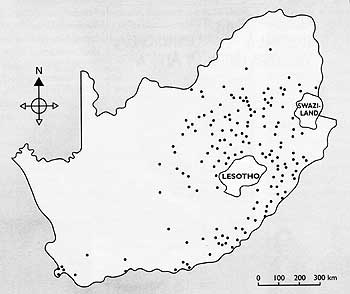 ICU branches between 1926 and 1930
ICU branches between 1926 and 1930
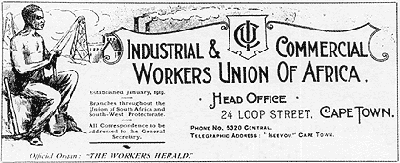
'Our aim is to bring together all workers in one big union. Then we will be able to fight for decent wages and working conditions.
The Industrial and Commercial Workers' Union (ICU) was first formed by African and coloured dockworkers in Cape Town in 1919. It soon became a general union and started organising workers in the docks, textile, food, clothing, engineering and agricultural industries.
The ICU grew quickly under the leadership of Clements Kadalie and A.W.G. Champion. By the mid 1920s, it had branches in Port Elizabeth, East London, the Central and Cape, the Orange Free State, the Transvaal and Natal.
In 1919 and 1920 the ICU was active when dockworkers in Port Elizabeth and Cape Town went on strike for higher wages. In Port Elizabeth the police opened fire, killing 21 people and injuring many more. Nevertheless, strike action led to wages being doubled.
'The AmaRespectables ... they speak the white man's language and wear good clothes; they read the white man's books and use his quotes against him ...'
As the ICU developed, its membership expanded to include teachers, small traders rural farm workers and labour tenants. Because people had been thrown off the land, it soon became more like a mass movement of those who had lot their land than a trade union.
At its height in 1927, the membership of the ICU was 100 000. News of the union had spread to the countryside to farmworkers in Natal, the Free State and the Eastern Cape. Those farmworkers were the lowest paid workers in South Africa when they were paid at all.
The ICU branch in Durban was led by A.W.G. Champion. He concentrated on fighting issues in the law courts. He fought and won many workers' cases against their employers. Some employers were fined for treating workers unfairly. Another victory for workers was won when the courts decided that Africans entering Durban no longer had to be dipped in disinfectant tanks, like animals!
The success of the ICU worried the government and the employers in the towns and the countryside. This is what General Hertzog, the Prime Minister of South Africa at the time, had to say about the ICU in 1926.
There were many divisions between the leaders of the ICU. Communist Party members had played a leading role in building the ICU. They attacked Clements Kadalie, accusing him of corruption and inefficiency. Kadalie responded by expelling them from the ICU. A further split developed between Kadalie and Champion. Champion broke away from the main organisation to form the ICU yase Natal.
After this, the ICU yase Natal started recruiting female beer-sellers to boost finances and membership. The ICU yase Natal took up and won the beer struggle, demanding the closure of municipal-owned canteens and the legalisation of domestic brewing.
By 1928, thousands of members were leaving because they had lost faith in the ICU. Among other problems, officials were accused of stealing the union's money. Some officials had been using workers' subscriptions to start small businesses, buy land and pay themselves good salaries.Trade unions in Britain sent Ballingerto help the ICU. But Kadalie and other ICU officials didn't get on with Ballinger. The ICU also had to face the power of the government. In the eyes of the government it was an illegal organisation. Laws were used to restrict the movement and activities of ICU officials. ICU offices were raided and documents burned. By 1930, the ICU had collapsed.
The development of the trade union movement
During the 1930s and 1940s attempts at organising workers into trade unions became more widespread. Some were more successful than others.
In 1930 the South African Trades and Labour Council (SATLC) was formed. Between 1930 and 1955 it was the largest body of trade unions in South Africa. It was made up of:
- craft unions which organised semi-skilled white workers, such as iron moulders
- white industrial unions who often relied on the racist policies of the government for support, such as the South African Iron and Steel Trades Association which grew into one of the largest and most conservative white unions
- racially-mixed trade unions which organised black workers as junior partners in their unions. For example, the Garment Workers' Union established a Number 2 Branch for coloured members. They were not, however, allowed representation on the executive of the Garment Workers' Union
- non-racial trade unions which organised all workers together, such as the Food and Canning Workers' Union and the Textile Workers' Industrial Union. These unions were based in industries where, as a result of World War II, there had been a large drop in the number of whites employed. It had become impractical for these unions to organise along racial lines.
Unions for African workers
Throughout this period African unions, while not illegal, were prevented by law from becoming registered. Only white, coloured and Indian workers were allowed to form and join registered unions. Registered unions had the right to:
- collect dues from their members
- represent workers in formal negotiations over wages
- try to sort out problems between workers and management.
By the end of the 1930s many thousands of Africans who had been squeezed off the land were working on mines and in factories. The number of Africans employed in industry expanded further because of World War II. More had to be done to organise this large urban African workforce into registered unions.
Until about 1940 African trade unions remained small, weak and divided. Following unity talks in 1941, the Council of Non-European Trade Unions (CNETU) was formed with Gana Makabeni as President and Dan Tloome as Vice-president.
By 1945 CNETU claimed 119 member unions nationally with a membership of 158 000 workers. Although CNETU won real wage increases for workers between 1941 and 1945, it didn't take on the battle to win formal recognition for its affiliates. In other words, the unions that belonged to CNETU still remained unregistered.
The weaknesses within CNETU showed most clearly during and after a strike by one of its affiliates in 1946, the African Mineworkers' Union. More on this strike follows below before considering the weaknesses that CNETU displayed at this time.
The 1946 African Mineworkers' Strike
In 1946 a strike called by the African Mineworkers' Union (AMWU) took place on the Witwatersrand. It was the biggest work stoppage the country had ever seen. Almost 76 000 workers went on strike. Their demands were:
- a minimum daily wage of ten shillings
- family housing
- two weeks' paid leave every year
- payment of repatriation fees*
- the repeal of War Measure 145 which had restricted the organisation of workers on the mines, by making it illegal for meetings of more than 20 people to take place on mine property.
The strike lasted for nearly a week before it was crushed. The government reacted very quickly and violently. About 1 600 police were called up on special duty. Compounds were closed off and kept under armed guard. Leaders were arrested. Most press reports presented the strikers in a very unfavourable light.
The decline of CNETU
When the miners' strike ended, CNETU called a general strike of all their unions as a way of showing support for the miners. But they couldn't communicate effectively with their members: workers were cut off from their leaders and lived under armed guard in the compounds. Because of the poor response to their call, CNETU was forced to call the strike off.
The 1946 African Mineworkers' Strike showed that black trade unions no longer had the same bargaining power as they had had during the war years. Many people lost their jobs. The defeat of the mineworkers seriously weakened CNETU. The situation was made worse by divisions within the leadership of CNETU.
Nevertheless, the strike had shown the potential power of organised black labour. And it had shocked employers and white voters who were afraid that they would be overpowered by blacks. The strike was a factor that led white South Africans to vote the Nationalist Party into power in 1948. This marked the beginning of 42 years of apartheid, a very dark period for the trade unions, for the liberation movements and for South Africans as a whole.
In the compound, in the townships. in the labour bureaus, in the reserves, the pattern created by South Africa's early industrialisation is still with us, the present is our history. understanding the past is the first step towards changing the pattern of the present.
From Gold and Workers by Lull Callinicos, 1980.